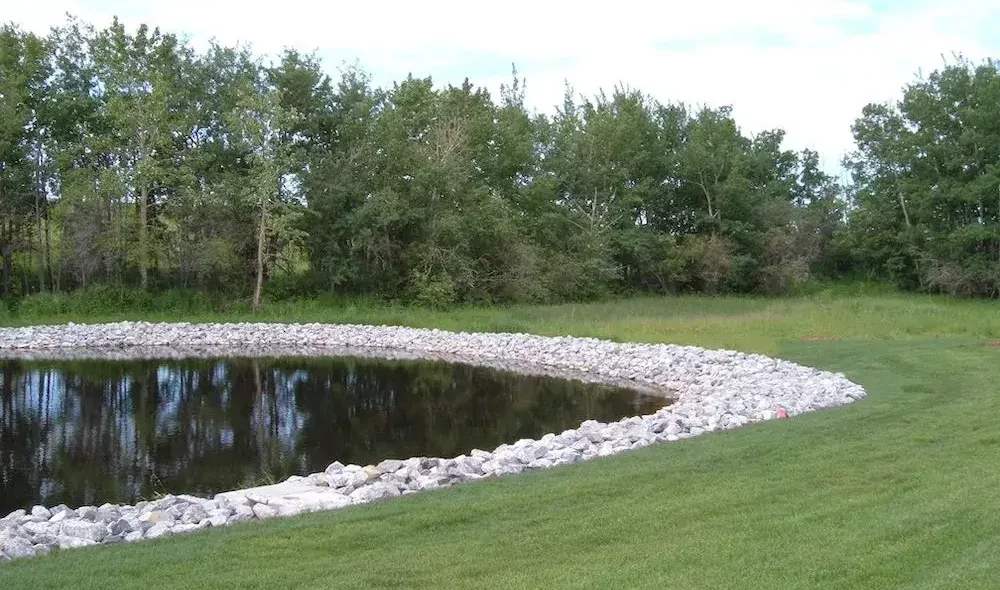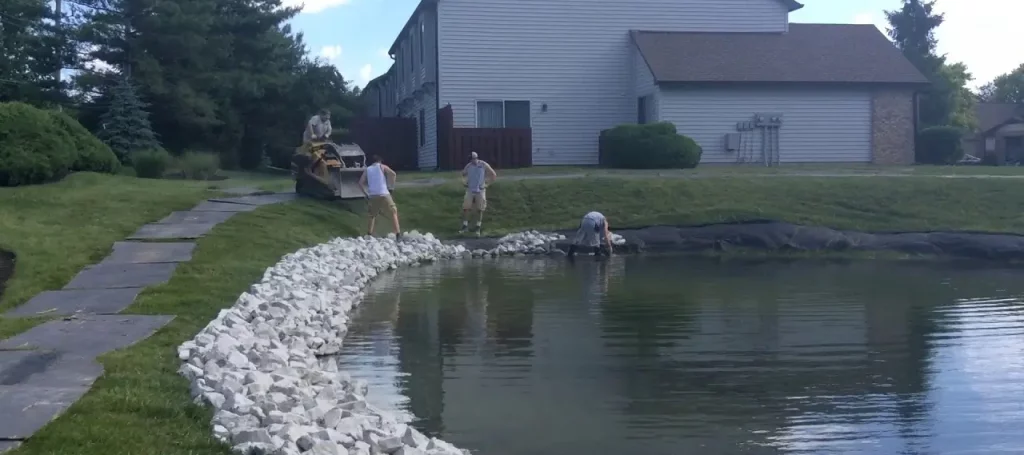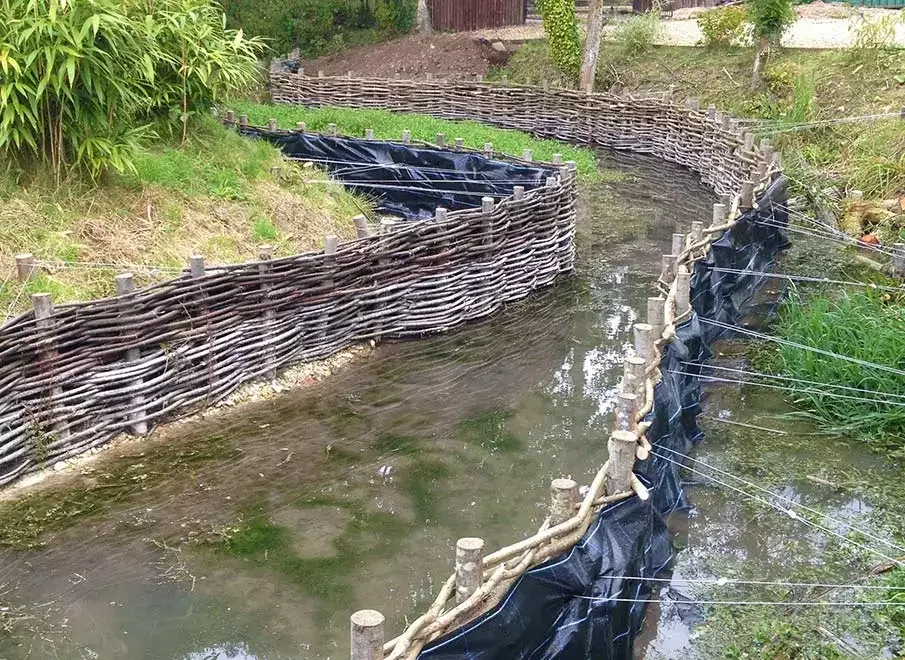If your pond is experiencing bank erosion, you’re not alone. This is a common problem for many ponds, and there are several ways to repair it.
In this blog post, we will discuss nine easy and effective methods how to repair pond bank erosion.
We’ll also provide tips on preventing this problem from happening again in the future. So if your pond is starting to look a little bit worse for wear, read on for some helpful advice.
Causes of Pond Bank Erosion
Before we get into how to repair pond bank erosion, we must understand what causes this problem in the first place.
Several factors can erode banks, and there isn’t always one single culprit.
However, some of the most common reasons for this type of waterbody damage include:
- Natural forces like wind and water
- Animal activity, such as burrowing by rodents or beavers
- Poor land management, like overgrazing or deforestation
- Improperly installed pond liners
- Human activity, like construction near the shoreline or dumping debris into it.
How to Repair Pond Bank Erosion

Now that we know what can cause pond bank erosion let’s look at how to repair it. There are three main methods that you can use, and each one has its benefits and drawbacks.
1. Erosion Control Blankets
Erosion control blankets are one of the most common ways to repair bank erosion.
These blankets are made from coconut fiber, coir mesh, or other materials, and they help prevent sediment loss while also stabilizing the soil with their root systems as plants grow into them over time.
They’re very easy to install because all you have to do is lay it down on top of your existing bank and then use stakes or sandbags to hold it in place.
The downside of erosion control blankets is that they can be expensive and ineffective in areas with high water flow rates.
2. Riprap
Riprap is an armor stone used to stabilize banks and prevent erosion. It’s made from large, flat rocks laid down in a row along the shoreline.
This method is very effective in slowing down or stopping the water flow, and it’s also relatively inexpensive.
The downside of riprap is that it can be difficult to install correctly, and it can damage aquatic habitats if not used properly.
It’s also important to ensure that the rocks are placed at least six inches above water level so they won’t be washed out by wave action during high tide periods.
3. Coir Logs and Mats
Coir logs are another way to repair pond bank erosion. These logs are filled with coconut fiber, a natural material that absorbs water and helps stabilize the soil around them over time (similar to erosion control blankets).
Coir mats are similar to coir logs, but they’re made from coir mesh instead of solid fiber.
This makes them more flexible and easier to install, but they also have a shorter lifespan than coir logs.
Coir logs and mats can be installed by simply placing them on the eroded bank and securing them in place with stakes or sandbags.
4. Install a Pond Liner

Pond liners are made from various materials, including PVC, rubber, and EPDM.
They’re designed to prevent water loss through evaporation and protect the soil below it from eroding by keeping out sunlight that can cause algae growth on top of your pond’s surface.
When installed properly with adequate drainage, a pond liner will help protect your waterbody while keeping it clean and clear.
The downside of this method is that liners can be expensive depending on how large they need to be for your property size. If you’re looking for how to repair bank erosion without breaking the bank, try out one of our other recommendations first.
5. Build a Shoreline Retaining Wall
If your pond is located close to a house or other structure, then you may need to build a retaining wall to protect it from the erosive forces of water and wind.
A shoreline retaining wall can be made from various materials, including concrete, stone, or wood, and it’s designed to hold the soil in place and keep it from washing away.
Retaining walls can be expensive to build, but they’re a permanent solution that will last for many years with proper maintenance.
If you’re looking to repair a pond bank erosion and your budget allows, then this may be the best option for you.
6. Plant Native Vegetation
One of the most natural and environmentally-friendly ways to repair pond bank erosion is planting native vegetation.
This can be done either by hand or with the help of a machine, and it’s a great way to improve the appearance of your property while also helping protect it from erosion.
Native plants are well-adapted to your local climate and soil conditions, so they’re more likely to thrive and survive than non-native plants.
They also provide food and habitat for native wildlife, which can be a great addition to your property.
If you’re not sure what types of plants would work best in your area, then consult with a local landscaping expert or your state’s Department of Natural Resources for more information.
7. Install a Stream Bank Protection System
Streambank protection systems are designed to prevent erosion along the banks of small streams and creeks.
They can be made from various materials, including concrete, stone, or wood, and they’re installed by piling them up against the stream bank.
This is a relatively inexpensive way to repair pond bank erosion, and it’s a permanent solution that will last for many years with proper maintenance.
If you’re looking for an easy way to protect your property from erosion damage, then this may be the best option for you.
8. Build a Dam
If the erosion is severe and your pond is no longer holding water, you may need to build a dam to prevent it from draining away.
This can be done with various materials, including concrete, stone, or earth, and it’s usually the most expensive way to repair bank erosion.
Dam construction should not be done without help from a professional engineer because mistakes can lead to major problems down the road.
If you’re looking to repair pond bank erosion and your budget allows, then this may be the best option for you.
9. Drain Your Pond
If all else fails, draining your pond is an effective way to repair pond bank erosion.
This is usually done by digging a large hole in its center and filling it with sand or gravel before covering it over the top so no water gets into your property anymore.
The downside of this method is that it can be expensive depending on how big you need to dig out, but if your budget allows, then it’s a viable solution.
There you have it – Nine different ways to repair pond bank erosion. Each one has its benefits and drawbacks, so choose the method that best suits your needs and budget.
What Can I Do to Stop Pond Bank Erosion?

Erosion is natural when wind, water, ice, and gravity wear away the earth’s surface.
While erosion can be a beneficial way to restore vital nutrients to the soil, it also causes severe damage to landscapes and areas around bodies of water.
It takes many forms: riverbank erosion, stream bank erosion along with water bodies, erosion around ponds and lakes, shoreline erosion along the ocean.
Pond bank erosion is the gradual destruction of a pond’s banks, often caused by rain, wind, and flowing water. Left unchecked, it can lead to serious problems for both the environment and property owners.
There are many ways to prevent or slow down pond bank erosion. However, the most effective methods depend on the severity of the problem and how much you’re willing to spend on repairs.
Here are some of the best ways how to stop pond bank erosion:
- Plant vegetation along the banks. This is one of the most effective and cheapest ways to prevent pond bank erosion. Vegetation stabilizes the soil and helps reduce water flow. It also provides a natural barrier against wind and rain.
- Install a retaining wall or fence. A retaining wall can help hold back soil and stop it from eroding away into the pond. Fences are also an option, but they need to be strong enough to withstand high winds and heavy rains.
- Add rocks or other materials along the edges of a pond. Rocks provide stability and prevent soil erosion by slowing down how fast water flows past them, which helps keep banks stable for longer periods of time.
- Raise the height of the pond banks. This is a more expensive solution, but it can be very effective in preventing bank erosion. It involves piling up earth along the edges of the pond to create a taller barrier that water and wind cannot easily penetrate.
- Install a drainage system. If your pond regularly experiences flooding, you may need to install a drainage system that can help channel excess water away from vulnerable banks and prevent them from eroding.
- Add an artificial pond bank. If none of the above methods work, then you may need to consider adding an artificial pond bank. This involves filling in areas around your pond with soil or other materials so they’re no longer prone to erosion.
However, no matter what method you choose, it’s important to take action as soon as possible to prevent further damage from occurring.
Pond bank erosion can be costly and time-consuming to fix, so it’s best to address it before it gets too bad.
With a little bit of effort, you can keep your pond’s banks looking beautiful and erosion-free.
Why not utilize bulkheads to prevent erosion??
One of the most common methods to repair pond bank erosion is building a bulkhead.
For example, stone walls are installed below the water’s surface or above it. But does this method work?
It can make erosion worse because built structures block natural currents and cause excessive buildup on one side that causes further scouring as the water flows around it.
Conclusion
Erosion is a natural process that can cause significant damage to landscapes and property.
There are many ways to stop pond bank erosion, but the most effective methods depend on the severity of the problem and how much you’re willing to spend on repairs.
If left unchecked, pond bank erosion can lead to serious problems for both the environment and property owners.
